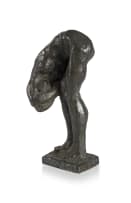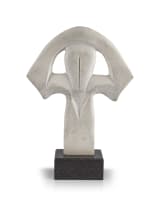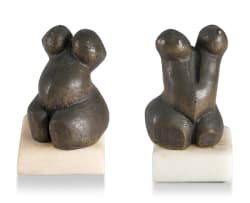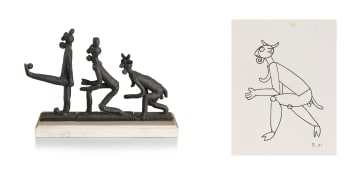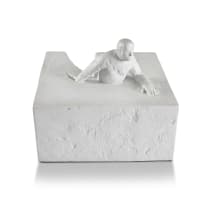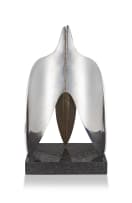Modern, Post-War and Contemporary Art
Online-Only Auction, 14 - 25 April 2022
South African Art at the Venice Biennale
About the SessionThis Venice Biennale-themed session in Strauss & Co's April online-only auction is timed to coincide with the launch of the 59th edition of the Venice Biennale in late April, and Strauss & Co’s sponsorship of the African Art in Venice Forum 2022 at Hotel Monaco & Grand Canal on 20 and 21 April. This session divulges the history of the Venice Biennale and South African art, as the art world converges on Venice. South Africa first became part of the Venice Biennale more than seventy years ago. The cordial relationship between Italy and South Africa over this period has nurtured international support for artists and art organisations in this country and continues to develop today.
Incl. Buyer's Premium & VAT
About this Item
signed, dated '16 and numbered 1/5
Notes
Accompanied by a Stevenson Gallery certificate of authenticity signed by the artist.
The fractured bronze sculpture at the centre of this lot was first exhibited in Wim Botha's untitled 2016 solo exhibition in Cape Town. The exhibition featured several paintings, various discrete sculptures, of which this was one of eight in black, as well as a multi-part installation composed of elements in wood, bronze and treated glass. The splintered form of this lot reiterates a formal device Botha introduced in a 2015 exhibition, the centrepiece of which was a radically splintered version of Michelangelo's first Pietà. Botha creates the ruptured surface of his splintered bronzes by first modelling the works in polystyrene and then altering their proportions with a chainsaw and wire cutter. Botha used the same process to construct this bronze. Although not entirely legible, the iconography of this bronze refers to the Grecian myth of Leda and the Swan. Botha previously worked with this troubling classical legend, which mingles power, eroticism and sexual violation, in a 2005 work, a ceiling-hung version of Leda and the Swan, its composite parts made out of bone meal and epoxy resin.
After acquiring this bronze, the seller commissioned Botha to add the additional glass elements, which are coated with dichronic filters. The updated work retains its original integrity, albeit now encompassing references to the artist's interest in light and refraction. This interest was fully explored in the artist's 2018-19 mid-career survey exhibition at Norval Foundation. An edition of the present lot (in its updated form) featured in that exhibition's main work, Studies for the Garden of Earthly Delights (2018), an enormous, multi-part installation composed of an amalgam of historical works by the artist. Critic Tim Leibbrandt described the installation as "utterly gorgeous" and "a thorough encapsulation of everything that Botha has been working towards in recent years".1
- Tim Leibbrandt (2019) "Intrinsic Field: Wim Botha's Heliostat," Artthrob, February: https://artthrob.co.za/2019/02/12/intrinsic-field-wim-bothas-heliostat/
Wim Botha exhibited at the Venice Biennale, South African Pavilion in 2013.
Provenance
Stevenson, Cape Town.
Private Collection.
Exhibited
Stevenson, Cape Town, Wim Botha, 13 October to 3 December 2016, another cast from this edition was exhibited.
Norval Foundation, Cape Town, Heliostat: Wim Botha, 29 September 2018 to 21 January 2019, another cast from this edition with a similar glass installation was exhibited.
Literature
Robin Kirsten (ed) (2019) Heliostat: Wim Botha, Cape Town: Norval Foundation, another cast from this edition illustrated on pages 105 and in Heliostat installation views pages 112- 114 and the front cover of the catalogue.
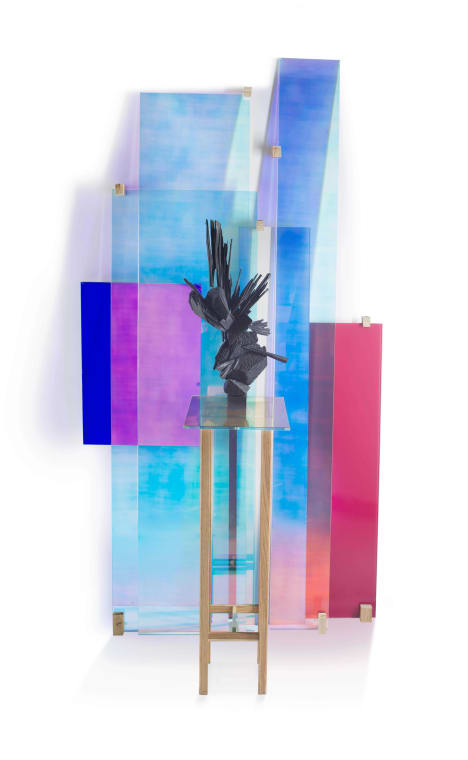
![Wim Botha; Prism 24 [Ecstatic], with glass installation](https://assets.straussart.co.za/t_thumb/items/0625/062551/wim-botha-prism-24-ecstatic-with-glass-installation-rr7035.jpg)
![Wim Botha; Prism 24 [Ecstatic], with glass installation](https://assets.straussart.co.za/t_thumb/items/0625/062551/wim-botha-prism-24-ecstatic-with-glass-installation-rr703a.jpg)
![Wim Botha; Prism 24 [Ecstatic], with glass installation](https://assets.straussart.co.za/t_thumb/items/0625/062551/wim-botha-prism-24-ecstatic-with-glass-installation-rr703f.jpg)
![Wim Botha; Prism 24 [Ecstatic], with glass installation](https://assets.straussart.co.za/t_thumb/items/0625/062551/wim-botha-prism-24-ecstatic-with-glass-installation-rr703k.jpg)
![Wim Botha; Prism 24 [Ecstatic], with glass installation](https://assets.straussart.co.za/t_thumb/items/0625/062551/wim-botha-prism-24-ecstatic-with-glass-installation-rr703p.jpg)
![Wim Botha; Prism 24 [Ecstatic], with glass installation](https://assets.straussart.co.za/t_thumb/items/0625/062551/wim-botha-prism-24-ecstatic-with-glass-installation-rr703u.jpg)
![Wim Botha; Prism 24 [Ecstatic], with glass installation](https://assets.straussart.co.za/t_thumb/items/0625/062551/wim-botha-prism-24-ecstatic-with-glass-installation-rr703z.jpg)
![Wim Botha; Prism 24 [Ecstatic], with glass installation](https://assets.straussart.co.za/t_thumb/items/0625/062551/wim-botha-prism-24-ecstatic-with-glass-installation-rr7045.jpg)
![Wim Botha; Prism 24 [Ecstatic], with glass installation](https://assets.straussart.co.za/t_thumb/items/0625/062551/wim-botha-prism-24-ecstatic-with-glass-installation-rr704a.jpg)
![Wim Botha; Prism 24 [Ecstatic], with glass installation](https://assets.straussart.co.za/t_thumb/items/0625/062551/wim-botha-prism-24-ecstatic-with-glass-installation-rr704g.jpg)
![Wim Botha; Prism 24 [Ecstatic], with glass installation](https://assets.straussart.co.za/t_thumb/items/0625/062551/wim-botha-prism-24-ecstatic-with-glass-installation-rr704m.jpg)
